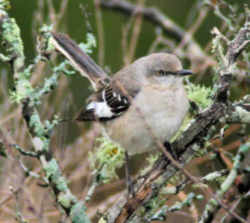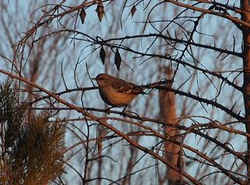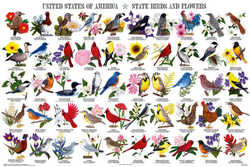
Texas Symbols
Texas State Bird
Mockingbird

(Mimus polyglottos)
Adopted on January 31, 1927.
The mockingbird, (Mimus polyglottos,) is the state bird of Texas, adopted by the Legislature by an act of the Legislature, approved on January 31, 1927, at the request of the Texas Federation of Women's Clubs.
The mockingbird was chosen as the official state bird because
- "It is found in all parts of the State";
- "...ornithologists, musicians, educators and Texans in all walks of life unite in proclaiming the Mockingbird the most appropriate species for the state bird of Texas";
- "...is a singer of distinctive type, a fighter for the protection of his home, falling if need be, in its defense, like any true Texan";
- "The Texas Federation of Women's Clubs named the mockingbird as the State bird of Texas and asked the Fortieth Legislature to adopt it."
The Northern Mockingbird, clad in shades of gray with conspicuous white wing patches, enjoys exceptional popularity for such a drab specimen, evident in the fact that it is the state bird of Arkansas, Florida, Mississippi, Tennessee and Texas.
Texas State Bird: Northern Mockingbird

The Mimus polyglottos, as the mockingbird is known scientifically, is about ten inches in length, including its relatively long tail. It has a light gray coat and a whitish underside. Its wings and tail are darker gray with white patches. The male and females look alike. Juvenile has spotted breast.
The common mockingbird of Texas is a superb songbird and mimic. Its own song has a pleasant lilt, varied and repetitive. Often it will sing all night long, especially in bright springtime moonlight. Unmated male mockingbirds sing more than mated ones. Both sexes sing in the fall to claim winter feeding territories. These areas are often different than their spring breeding territories.
The song of the mockingbird is, in fact, a medley of the calls of many other birds, each repeated several times. It will imitate other species' songs and calls, squeaky gates, pianos, sirens, barking dogs, etc. Each imitation is repeated two or three times, then another song is started, all in rapid succession. In the above sample audio file, the songs of four distinct species were recorded in the span of about seven seconds. It is common for an individual bird to have as many as 25-30 songs in its repertory.
The mockingbird is also known as a fierce protector of its nest and environment. It is sometimes seen swooping down on a dog, cat or predator that may be venturing too close to the bird's protected territory.
Identification of the Northern Mockingbird
- Abundance: Common urban bird
- Length: 10 inches
- Weight: 1-3/4 ounces
- Wing Span: 14 inches
- General description: Diurnal, omnivore, altricial
- Sexual maturity : 1 year
- Mating season: Spring and early summer. Mockingbirds usually nest twice a year sometimes 3 or 4 times when conditions are favorable.
- Breeding territory: 1 pair per 20 acres
- Gestation: Eggs hatch in 12-13 days, the young fledge 11-13 days after that.
- Number of young: Eggs are blue-green with brown markings. The 2-6, usually 3-5, eggs per nest are a pale blue-greenish with brown spots.
- Nest Location: Ground-low nesting
- Nest Type: Open-cup The nest, a joint male/female project, is a bulky, open cup of grass, twigs and rootlets carelessly arranged in a dense.
- Migration Status: Permanent resident. This year-round resident is known for its fierce defense of the family nest.
- Diet: Mockingbirds require open grassy areas for their feeding, thick, thorny shrubs for hiding the nest and high perches where the male can sing and defend his territory. Gardens are among its favorite dwelling places especially if winter berries are available. The Mockingbird's primary diet is insects (beetles, ants, grasshoppers and spiders),berries and seed.
- Facts:
- Only unmated males sing at night.
- Mockingbirds often form long-term pair bonds.
- Mockingbirds vigorously defend their territory against many other species including dogs, cats and man!
- Female mockingbirds often build a new nest while the males finish feeding older fledglings and teaching them to fly.
- Scientists have found that female mockingbirds are attracted to males that can make the most different sounds.
- Mockingbirds are the state bird of Arkansas, Florida, Mississippi, Tennessee, and Texas and one of the few birds found in every kind of habitat, from desert to forest to city.
- Mockingbirds are thought to raise and lower their wings in order to scare up a meal of insects, frighten snakes and impress their mates.
History of the Mockingbird
Ask any Texan, and you will no doubt learn that the mockingbird has the prettiest song of any bird native to North America. That's perhaps the chief reason the "mocker" was adopted as the state bird of Texas in 1927. Legend has it when Texas chose the mockingbird as its State bird, the resolution stated that the bird is "a fighter for the protection of his home, falling, if need be, in its defense, like any true Texan..." Its species name comes from the Greek mimus to mimic, and ployglottos for "many-tongued."
Texas Senate Concurrent Resolution No. 8
The law designating the mocking bird, or mockingbird as the official Texas state bird was made by an act of the Legislature, and was approved on January 31, 1927.
THE MOCKING BIRD DECLARED TO BE THE STATE BIRD.
[S. C. R. No. 8.]
WHEREAS, the State of Texas at present has no state bird, and
WHEREAS, the Texas Federation of Women's Clubs has adopted appropriate resolutions on this subject, as follows:
SELECTION OF A STATE BIRD.
"WHEREAS, The Texas Federation of Women's Clubs is supporting a program for the protection of birds and sponsors any legitimate movement that has
for its object an increased interest in their economic and aesthetic value and a more intelligent and sympathetic understanding of our feathered
friends; and
"WHEREAS, The committee on birds and flowers, after investigation and deliberation, thinks the time is opportune for the selection of a state bird;
and
"WHEREAS, Ornithologists, musicians, educators and Texans in all walks of life unite in proclaiming the mocking bird the most approprate species
foe the state bird of Texas, as it is found in all parts of the state, in winter and in summer, in the city and in the country, on the prairie and
in the woods and hills, and is a singer of distinctive type, a fighter for the protection of his home, falling, if need be, in its defense, like
any true Texan;
"Therefore BE IT RESOLVED, That the Texas Federation of Women's Clubs in convention assembled, go on record as naming the mocking bird the state
bird of Texas, and asking that confirmation of such action be had at the approaching regular session of the 40th Legislature ;" therefore be it
RESOLVED BY THE SENATE OF THE STATE OF TEXAS, THE HOUSE OF REPRESENTATIVES CONCURRING:
That the recommendation of the Texas Federation of Women's Clubs be and are hereby adopted and that the mocking bird be and the same is hereby
declared to be the state bird of Texas.
Approved by Governor, January 31, 1927.
Texas Law
The law designating the mocking bird, or mockingbird as the official Texas state bird is Section 3101-007 (STATE BIRD) of the Texas Statutes, GOVERNMENT CODE specifically Title 1 (GENERAL PROVISIONS) Chapter 3101 (STATE SYMBOLS) Section 3101-007.
GOVERNMENT CODE
TITLE 1.
CHAPTER 3101. STATE SYMBOLS.
SECTION 3101.007.
§ 3101.007. STATE BIRD. The state bird is the mockingbird.
Added by Acts 2001, 77th Leg., ch. 1420, §7.001, eff. Sept. 1, 2001.
Taxonomic Hierarchy: Northern Mockingbird
Kingdom: Animalia (animal)
Phylum: Chordata (chordates)
Subphylum: Vertebrata (vertebrates)
Class: Aves (birds)
Order: Passeriformes (perching birds)
Family: Sturnidae (starlings)
Genus: Mimus Boie, 1826 (mockingbirds)
Species: Mimus polyglottos (Linnaeus, 1758) - Centzontle norteno (northern mockingbird)
Scientific Name: Mimus polyglottos
Taxonomic Serial Number: 17862







